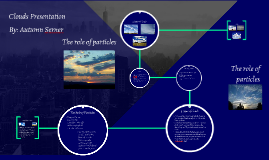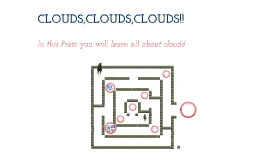Clouds Presentation
Transcript: Cloud Formation Summary of Key Points Ongoing and Future Studies on Clouds Process of Condensation Clouds form primarily through the process of condensation, where water vapor in the atmosphere cools and transforms back into liquid droplets. Understanding the dynamics of cloud formation is crucial for predicting weather patterns and assessing climate impacts. Condensation occurs when water vapor in the air cools and changes into liquid water droplets. This process is essential for cloud formation, as tiny droplets cluster around particulates, forming visible clouds when the saturation point is reached. Clouds are categorized into different types such as cirrus, cumulus, and stratus, each with unique characteristics. They influence weather patterns, climate regulation, and play integral roles in hydrological cycles, thus impacting ecosystems. Research on clouds includes advancements in satellite technology and modeling techniques. Scientists are investigating cloud microphysics and their effects on precipitation to enhance forecasting accuracy and climate models. Role of Temperature and Pressure Types of Atmospheric Conditions Temperature and pressure are critical factors in cloud formation. As air rises, it cools, reducing its capacity to hold water vapor, leading to condensation. High pressure typically results in clear skies, while low pressure favors cloud development. Different atmospheric conditions promote cloud formation. Warm, moist air is conducive to cumulus clouds, while stable, cooler air leads to stratus clouds. Additionally, frontal boundaries and orographic lifting trigger diverse cloud types, affecting weather patterns. Importance of Clouds in Climate Change Research Conclusion and Future Research Clouds significantly influence global warming by affecting both solar radiation and Earth's heat retention. Current research assesses cloud feedback mechanisms to better understand their role in climate change and inform climate policy. Clouds play a crucial role in Earth's weather and climate systems, affecting temperature regulation and precipitation patterns. Understanding clouds enhances our comprehension of atmospheric processes and climate dynamics. Cirrostratus Clouds Cirrus Clouds Types of Clouds Cirrostratus clouds are thin, ice-crystal clouds that cover the sky and often create halos around the sun or moon. Formed at high altitudes, they indicate potential changes in weather, particularly the approach of a warm front. Cirrus clouds are high-altitude clouds that form above 20,000 feet and are composed of ice crystals. They appear wispy and thin, often indicating fair weather, but can also signal an approaching storm when they thicken. Clouds come in various types, each uniquely defined by their shape, altitude, and formation process. Understanding these types is crucial for predicting weather patterns and phenomena. Clouds Presentation Cumulus Clouds Altostratus Clouds Altostratus clouds are gray or blue-gray clouds that form at mid-altitude, typically between 6,500 to 20,000 feet. They often cover the entire sky and can bring rain or snow when accompanied by other cloud types. Cumulus clouds are fluffy, white clouds with a cotton-like appearance, typically forming at low to mid-level altitudes. They usually indicate fair weather but can develop into larger storm clouds under the right conditions. Nimbus Clouds Nimbus clouds, particularly nimbostratus, are thick, dark clouds that result in continuous precipitation. They are characterized by their low altitude and widespread coverage, often leading to gloomy weather. Stratus Clouds Stratus clouds appear as uniform gray layers covering the sky, often resembling fog. These low-lying clouds can bring light rain or drizzle and typically indicate overcast conditions. Exploring Types, Formation, and Impact of Clouds Brief History of Cloud Studies Introduction to Clouds The study of clouds dates back to ancient civilizations, with early descriptions recorded by Aristotle. Modern meteorology began in the 19th century, leading to advances in cloud classification and understanding of their effects on the weather. Clouds are essential components of the Earth's atmosphere, influencing weather patterns and climate. They form as tiny water droplets or ice crystals suspended in the air, providing critical insights into meteorological processes. Importance of Clouds in Weather Systems Definition of Clouds Clouds are visible aggregates of water droplets or ice crystals floating in the atmosphere. They form when water vapor condenses around microscopic particles, leading to diverse shapes and types based on atmospheric conditions. Clouds play a critical role in weather systems by influencing precipitation, temperature, and atmospheric circulation. They affect energy balance by reflecting sunlight and trapping heat, thus impacting local and global climates. Influence on Climate Clouds contribute to climate by reflecting sunlight and trapping heat. This

















